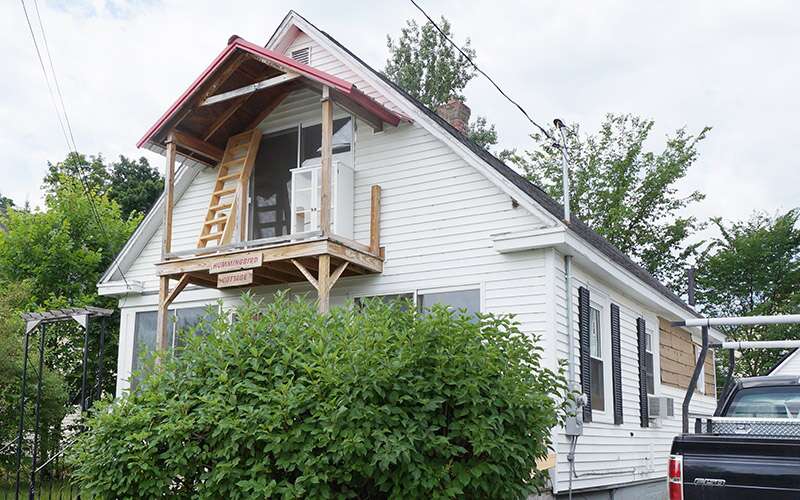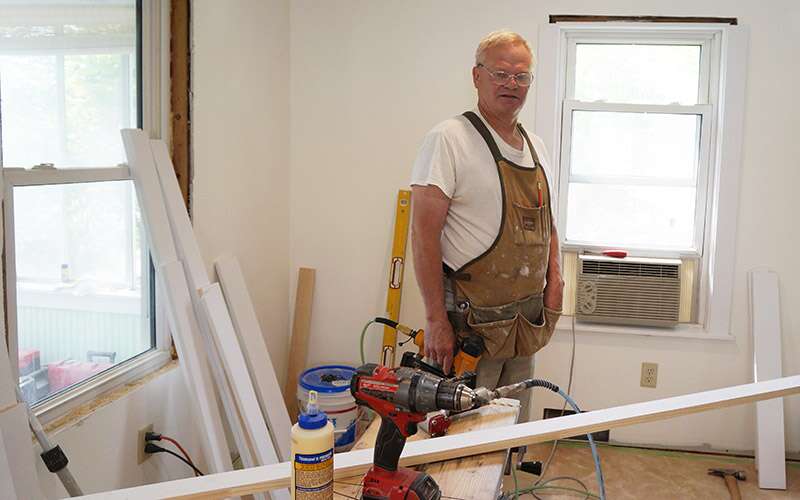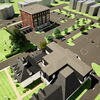
Millinocket Housing Initiative making progress
 Photo / Maureen Milliken
Ailish Keating, project manager for the Northern Forest Council's MIllinocket Housing Initiative stands in front of the first property to be renovated, on Central Street.
Photo / Maureen Milliken
Ailish Keating, project manager for the Northern Forest Council's MIllinocket Housing Initiative stands in front of the first property to be renovated, on Central Street.
MILLINOCKET — The houses the Northern Forest Center have bought in town as part of its housing initiative all have something in common — without the program, they probably would be torn down or languish on the market without a buyer.
The program began last fall and plans are to buy 10 houses and multi-family buildings, renovate them and rent them out. All of the buildings would be sold within seven years.
The focus is on downtown houses, within walking distance of the elementary school and hospital with the goal to create workforce housing for employers, including Millinocket Regional Hospital.
The Center has raised loan capital from “impact investors” — such as the Maine Community Foundation and individuals — to buy and renovate property, said Rob Riley, president of the Northern Forest Center. “Our initial goal for the project was to raise $1 million in loan capital in five and seven-year notes and have room for a few additional investors to participate.”
He said the properties would be sold within the seven-year window first laid out in the project.
Job losses that began when the Great Northern Paper mill closed in 2008 had a ripple effect on the economy, as well as housing, and the vacancy rate in town was 17% when the program began, with many of the houses in disrepair or abandoned.
Lack of quality housing is cited by employers who hope to attract professionals, particularly at Millinocket Regional Hospital, the town's biggest employer, with a staff of 250, the program's organizers said last year. But it's also cited by smaller businesses, they said, and the blossoming recreational tourism industry, whose seasonal workers have trouble finding rental units.
Three of the six properties acquired so far have been renovated and are occupied — a two-family on Central Street, the project’s first property and single-family homes on Oxford Street and Aroostook Avenue.
Project Manager Ailish Keating said Tuesday that all of the tenants in the property that has been renovated and rented out so far under the program are from outside of the area, meeting a goal of the project to have workers relocate to town.
Another multi-family, on Penobscot Avenue, already had tenants who are satisfied with the condition of the building and renovations will wait, Keating said. She said rents there won’t change until renovations are down.
A single-family at 56 Congress St. is under renovation and should be available for rent by the end of the summer.
The program’s biggest challenge, a multi-family on Katahdin Avenue, may begin in the fall.
Hummingbird Cottage

Tuesday morning, at a the little white New Englander on Congress Street, contractor Mike Brown and his crew were putting the finishing touches on what had been a complete gut renovation.
The Northern Forest Center bought the 1,400-square-foot New Englander for $47,000, and renovations began in the spring. The house should be ready to rent later this summer.
The house, built in the 1920s, had a tight interior layout with a narrow staircase accessed to the bathroom to the two bedrooms on the second floor.
“It was a complete remodel,” said contractor Mike Brown.
A new staircase was built in a more convenient place, walls were taken down, the bathroom enlarged and wiring and insulation added.
“If the layout hadn’t been so squirrely, it would have been less of a project,” said Keating.
“It’s a cute house,” she added, saying aside from reworking the interior, there was little wrong with it that wasn’t cosmetic.
Brown said that under linoleum the original white birch floors were black, but once sanded, they now shine. The house was rewired,
Contractors were able to keep most of the windows and are also keeping a small balcony a previous owner built on the front and a gazebo in the grassy backyard. The house has three-season porches on the front and back and a one-car detached garage.
The house was furnished when the project bought it, and the new tenants will also have an upright piano in the living room.
Also staying is a sign on the front: “Hummingbird Cottage.”
The house is a two-block walk from downtown and it overlooks a park along Millinocket Stream and the Mike Michaud Walking Trail, which loops downtown.
'Not renovating just to renovate'

Keating said the buildings are renovated as contractors begin available and the logistics of renovating are worked out.
The first project that was finished was at 26 Central St., a 2,100-square-foot two-family that was bought for $30,000.
The 1,480-square-foot single-family house on Oxford Street and the 1,663-square foot one on Aroostook Avenues were bought for $45,500 and $27,000, respectively.
The project bought the Penobscot Avenue multi-family, a block from downtown, for $34,000.
Local contractors are used for the all the work, and Keating said availability depends on the season. More are available in the colder-weather months when seasonal camps that can’t be accessed in the winter aren’t being worked on.
“Renovations are always more costly and take longer than you think,” Keating said. “Ask anyone who’s done a renovation.”
She said building costs have also gone up, but labor costs in the area have stayed stable.
“We’re not just renovating houses to renovate houses,” Keating said. The non-profit program not only provides needed workforce housing, but also employs local contractors and puts houses that were vacant back into use.
The more “robust housing” the town has, the more employers like Millinocket Regional Hospital, the town’s largest employer, will be able to recruit workers from outside the area.
With the development of the mill site, which is just steps from many of the properties, the need for workforce housing will grow.
Biggest challenge so far

The biggest challenge the project has taken on is 100 Katahdin Ave. The three-story, five-unit 1901 building is down the street from the gate of the mill.
The project acquired the 3,400-square-foot building for $5,500 from the town, which had seized it because of non-payment of taxes.
Some of the rooms inside are stripped to the studs. Others are worse — old, mildewed carpeting and ripped linoleum covers the floors, paint is peeling and cabinets hang of kitchen walls. Most of the windows are broken.
Keating said there can be a romantic misconception about what the project is about, but the Katahdin Avenue house is an example of what it’s actually about.
When the project bought it, the town had already spend $15,000 to get rid of asbestos, but Keating points out it’s likely no one would have taken on the renovation.
Still, the building appeals to the project. It’s across the street from Veteran’s Park and a quick walk to the mill site or the hospital. Underneath the grime and wear, the Victorian bones are still visible.
She said the plan is to probably make it three units and the renovation could cost $180,000 or more.
Rile, the NFC president, said the organization is looking to raise some additional philanthropic money for the project.
Keating said once the building is renovated, which may begin this fall, it’ll be emblematic of the program as a whole.
“Really what we’re trying to do is make a healthy downtown corridor,” she said. The Katahdin Avenue renovation, as well as the others, “really set the tone.”
Read more
Redevelopment of shuttered Millinocket mill gets $5.3M boost










Comments